If you buy through our links, we may earn an affiliate commission. This supports our mission to get more people active and outside.Learn about Outside Online's affiliate link policy
8 Best Triathlon Running Shoes in 2025

We put many shoes through a rigorous 10-point test to bring you the best triathlon running shoes of 2025. (Photo: Triathlete)
Speed in triathlon comes from a variety of sources – from incredible quick-change acts in transition to grabbing cups at aid stations without changing your stride.
The triathlon running shoes you choose have more bearing on your final time than just how well you run in them. Transition speed, whether you can go sockless comfortably, and how well they handle moisture can all impact your performance.
Our team of editors has tested and reviewed eight leading running shoes based on a variety of criteria to help you make informed decisions about what to wear for your next training session or race.
Best triathlon running shoes criteria
| Overall Rating | A combination of the ratings below, plus other intangibles - from the perspective of a multisport athlete. On a scale of 1-5. |
| Overall Value | This rating compares the value of the triathlon running shoe compared to others in the category with similar features. On a scale of 1-5. |
| Best Distance | Based on weight, cushioning, and durability, this rating describes which triathlon (and run) distances are most appropriate for this shoe. |
| Heat Dissipation | This rating gives a value on how effective the shoe is for hot days or triathletes with feet that can run hot. Conversely, a higher-rated shoe will be less appropriate for cold conditions (without making adjustments). On a scale of 1-5, with 5 being a very cool shoe for very hot days/hot feet. |
| Water Drainage | This rating describes how well the shoe drains water from sweat, fluids poured on the head, or melting ice. On a scale of 1-5, with 5 having excellent drainage. |
| Sockless Comfort | This rating describes how comfortable the shoe is when it is worn without socks. On a scale of 1-5. |
| Transition Speed | This rating describes how quickly the shoe can be put on, relative to other shoes in the category - assuming the wearer uses the included laces. This can include factors like heel tabs, one-piece tongue, high ankle collar, and more. On a scale of 1-5. |
| Durability | This rating describes the durability of the shoe's materials, extrapolated over short-term testing and based on any manufacturer guidance (if given). On a scale of 1-5. |
What makes our reviews different? Our testers actually use the thing. A lot. Learn more about Triathlete’s gear review process.
Best running shoes for triathlon, tested and reviewed – racing shoes
Hoka Rocket X 3
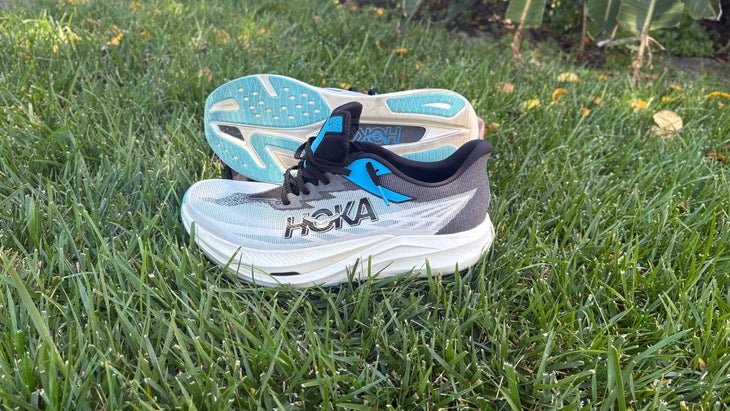
In our opinion, Hoka’s Rocket X 3 is one of the best pairs of carbon-plated super shoes for triathletes across all distances. We saw them on the feet of fifth-place 2025 Ironman World Championship finisher Sam Laidlow, so you know they can move, but in our extensive testing, we wouldn’t cast these aside for our slowest long runs either.
While there is still a very distinct rocker, we found a super-open “landing zone” where the shoe felt comfortable – rare on a rockered, carbon-plated super shoe, especially with the Hoka Rocket heritage. Certainly, we sensed the greatest benefit at faster speeds – most specifically downhills, where the speed was effectively “free” – but they never felt awkward as our pace got closer to 9- or 10-minute miles on easy days or recovery intervals.
At threshold or higher speeds, we definitely felt the well-placed rocker push us into my most effective running posture, which is truly the best you can hope for in a super shoe. We felt our whole center of gravity move forward, and our core engage in a way that very few shoes encourage.
Triathletes can also benefit from the incredibly breathable, lightweight mesh upper construction that seems purpose-made for multisport. Drainage was top-notch, as was breathability. The only small strike against these shoes is that the mesh has a very rough feel – something you’d never experience unless you went sockless; as such, we do not recommend these sockless.
Also, unlike other super shoes focused entirely on weight (these being a little on the heavier side, hovering around eight ounces), the outsole is durable and will last for a few seasons. And this is the main crux of why the Rocket X 3 presents such a great value – despite retailing for $250: You can wear these shoes more often, at a wider range of speeds (allowing for more adaptation, prepping for race day), and not worry about them falling apart after a few months.
All that said, the one thing this shoe decidedly cannot do (which is the same as almost all road super shoes, to be fair) is anything even remotely off-road. Even the hardest-packed gravel caused slippage, likely thanks to the forward position and high stack.
| Overall Rating | ★★★★★ |
| Overall Value | ★★★★★ |
| Best Distance | All distances |
| Heat Dissipation | ★★★★ |
| Water Drainage | ★★★★ |
| Sockless Comfort | ★★ |
| Transition Speed | ★★★ |
| Durability | ★★★★★ |
Specs
| Weight | 8.1 oz /men’s U.S. size 10 |
| Stack Height | 42-35 mm toe/7 mm drop |
| Price | $250 |
Adidas Adios Pro 4
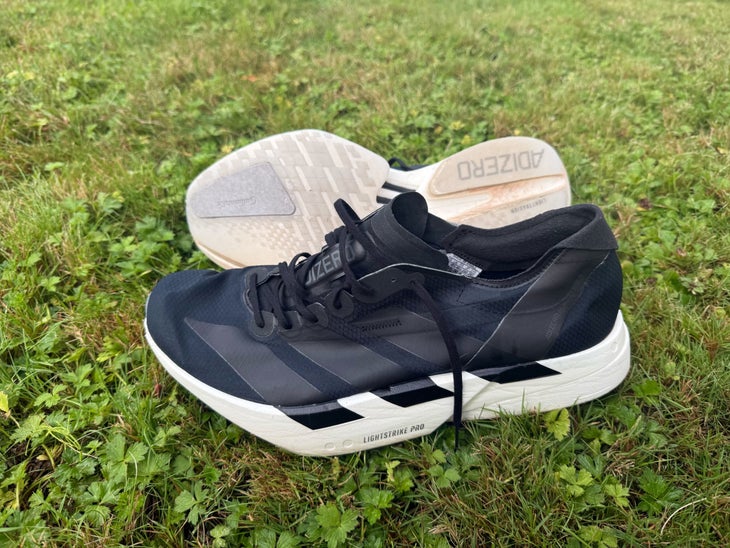
This has quickly become one of our favorite shoes in recent memory, with an aggressive rocker that puts us up on our toes, making us feel like Alistair Brownlee of old. It’s the kind of shoe that makes you smirk when you pick it up for a session, knowing it’s going to feel faster than you might actually be.
The energy return is also some of the best we’ve ever felt from a super shoe. The foam compresses almost completely underfoot when running off the wider-than-expected forefoot. When we tried an exaggerated heel-striking run form, however, the ride felt much less responsive – making it tougher to run at easier paces (around 9-minute miles) unless we stayed up on our toes, engaged our core, and really trusted in a forward-leaning form.
The upper feels breathable and comfortable, even when sockless or running with wet shoes and socks. The material surprised us with how waterproof and durable it was – especially for the overall weight. The added heel supports locked our feet into place securely, which became even more important when testing them in wet and sockless conditions to simulate a triathlon.
However, we would recommend them for shorter, faster distances. If you can hold those quicker paces for long-distance races – and your Achilles’ are strong and generally happy – your quads and calves will definitely thank you, and so will your overall pace.
But if you’re in the same boat as our testing team, and skeptical that the jelly legs after the bike won’t be stable enough on such a serious shoe – perhaps look toward the Adizero EVO SL – a non-supershoe alternative with the same impressive Lightstrike Pro foam that’s a lot more stable in our experience.
| Overall Rating | ★★★★★ |
| Overall Value | ★★★★★ |
| Best Distance | Sprint, Olympic, 70.3 (5K, 10K, half marathon) |
| Heat Dissipation | ★★★★ |
| Water Drainage | ★★★★★ |
| Sockless Comfort | ★★★★ |
| Transition Speed | ★★★★ |
| Durability | ★★★★ |
Specs
| Weight | 7.05 oz men’s size 9/women’s size 7.5 |
| Stack Height | 39-33mm / 6 mm drop |
| Price | $250 |
On Cloudboom Strike LS (LightSpray)
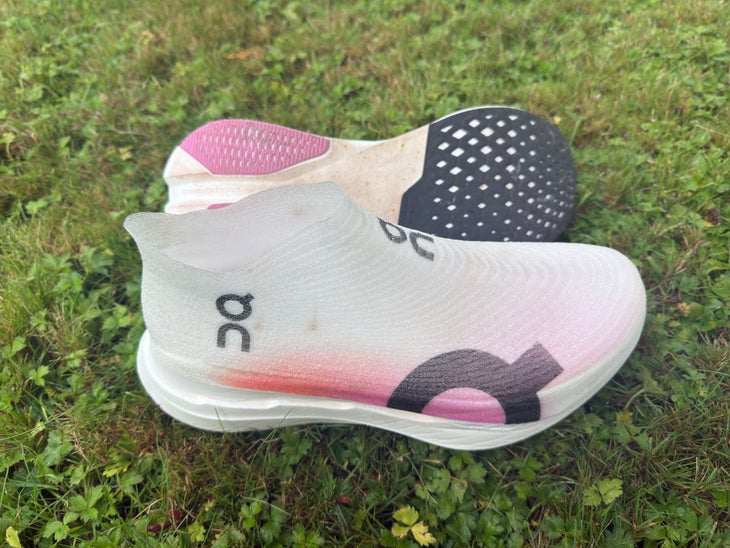
The self-proclaimed “revolutionary shoe” worn by two of the Norwegians on the podium at the recent men’s Ironman World Championship in Nice has been turning heads since its mid-2024 release. But it first made waves earlier that year when Helen Obiri wore a prototype pair at the Boston Marathon.
These spray-on shoes immediately caught our attention straight out of the box. They’re so transparent you can see the silhouette of your hand through them – and they’re incredibly light, about an ounce-and-a-half less than the regular Cloudboom Strike.
Sliding into them for the first time was that unique experience we expected. It was tough at first, with such a small opening, but there’s a technique to it, and we quickly built trust in the spray-on filament – since you really have to grip and rip them on. It got easier with time, though we don’t think you’d ever be faster than standard triathlon shoes with elastic laces.
The upper material is firm with just enough stretch, and it feels comfortable with or without socks. It is important to note that the fit was tighter and narrower than any shoe we’ve tested recently, although it broke in significantly. Because of that, we’d highly recommend testing sizing carefully, and you’ll really want to break them in substantially before diving into a race.
The foam is noticeably stiffer than other super shoes at a similar price point, like the Adidas Adios Pro 4 above. That stiffness makes it feel far more stable at slower speeds or when heel striking. Over time, the foam softened, striking a great balance between speed and comfort – convincing me this could be a great choice for a longer race.
Sockless, the shoes remained dry, even when we intentionally soaked them, and they would dry out in minutes. However, keep in mind, with this shoe, you’re running directly on the foam without a liner and with only a small piece of grip in the toe box. Because of that, we found our forefoot stayed stable while our heel felt looser than expected during those first few minutes when wet.
Overall, it’s an impressively fast, fun, and surprisingly stable shoe. We expect it will only grow in popularity and be seen regularly in triathlons as On ramps up the tedious production to meet the demand. For now, you’ll have the best luck finding it in select On flagship stores.
| Overall Rating | ★★★★ |
| Overall Value | ★★★★ |
| Best Distance | All distances |
| Heat Dissipation | ★★★★★ |
| Water Drainage | ★★★★★ |
| Sockless Comfort | ★★★★★ |
| Transition Speed | ★★★★ |
| Durability | ★★★★ |
Specs
| Weight | 6oz men’s size 8.5; 5.7 oz women’s size 7 |
| Stack Height | 39.5-35.5 mm / 4 mm drop |
| Price | $330 |
Mount to Coast R1
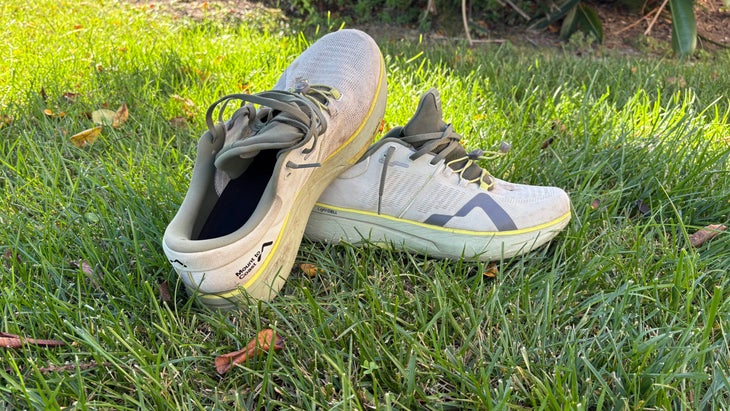
Like many, we were initially skeptical of Hong Kong-based Mount to Coast when they appeared on the market last year. There were rumors of influencer-seeding, they had paid ad banners plastered everywhere, and they were, well, relatively inexpensive and new. But, like almost every professional run/tri editor I’ve spoken to in the last 12 months, we have to say we’re sold. While we’ve called Mount to Coast’s offerings “the most ‘harmonious’ line of running shoes we’ve ever tried,” pretty much everyone can agree that one of Mount to Coast’s models is a great fit for them.
When it comes to triathlon running shoes – particularly ones that triathletes will race in – the Mount to Coast R1 is the best option right now. Created as an ultra-distance road racing shoe (not carbon-plated and not dubbed a “super shoe”), pretty much every runner who heads out the front door can benefit from the stability, consistency, and flawless details on the R1, and this truly includes long-course triathletes, specifically.
The midsole of the R1 is as predictable and forgiving as they come, without devolving into marshmallowy fluff like some high-stack “super trainers.” The relatively moderate stack height is a boon for those who appreciate a more traditional-feeling shoe, but the details on the upper and outsole are about as modern as anything else out there. This is a shoe that will support your legs after many hours of biking and running from the first step to the last without any wild rockering or finicky carbon plates.
The only things that prevent the R1 from being a five-star choice for triathletes are that the material is not super conducive to draining water, nor zipping out of transition quickly. While the unique two-tiered lacing system is actually amazing for long-distance running – dialing in the fit precisely and allowing for mid-run changes as feet swell – it’s a little slow to get on, even with practice. But if a fast transition isn’t super important to you (and you don’t get super hot feet), then the R1 is definitely a five-star shoe for the right triathlete.
| Overall Rating | ★★★★ |
| Overall Value | ★★★★★ |
| Best Distance | 70.3, iron-distance, and up |
| Heat Dissipation | ★★★ |
| Water Drainage | ★★★ |
| Sockless Comfort | ★★★★ |
| Transition Speed | ★★ |
| Durability | ★★★★★ |
Specs
| Weight | 8.5 oz men’s size 9/women’s size 7.5 |
| Stack Height | 35–27 mm / 8 mm drop |
| Price | $160 |
Tracksmith Eliot Racer
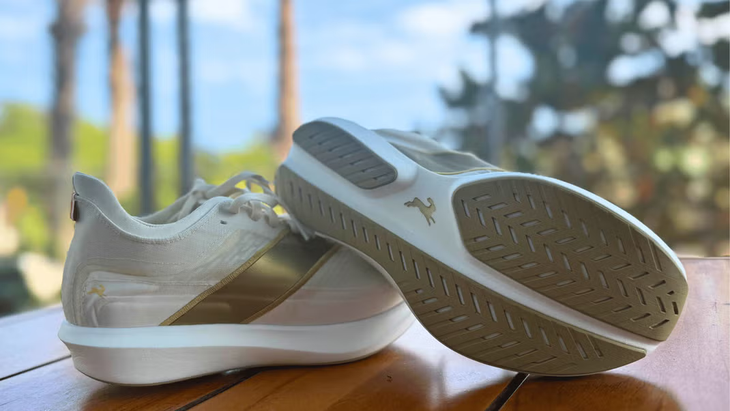
As Taylor Knibb once said, “triathletes prioritize performance over looks.” Maybe that’s why so much triathlon gear looks so dorky. Well, you can have it all with the Tracksmith Eliot Racer, an elegant super shoe with the quality, durability, and versatility to justify the price tag.
Underfoot, the Tracksmith Eliot Racer is pretty much a perfect super shoe. It’s bouncy enough without feeling sloppy, overly squishy, or slippy – which our testers especially appreciated when they were tired, which of course triathletes always are when leaving T2.
That’s largely thanks to the rocker, which is shaped like an exponential curve. It lends for a delightfully stable stance while your foot sinks into the thick foam before rebounding with a quick roll, and makes the shoe exceedingly comfortable (and fast feeling!) from 5K to marathon pace.
In true Tracksmith form, the Eliot Racer uses high-quality materials that are durable, while still giving a light-enough, high-performance feel. That’s reflected in the translucent and breathable (yet surprisingly resilient) upper and the suede-like, lightly padded tongue and heel collar. (These materials, along with a woven material on the drop-in midsole, are exceptionally soft for bare feet.) And it extends to the outsole, which has enough rubber to make this shoe a workhorse on everything from the track to dirt roads. (And helps give the shoe a long life.)
The only dings we give the Eliot Racer are that the removable drop-in midsole can get a little squeaky underfoot, especially when wet. The slightly wonky heel collar may rub some feet without socks, although our team didn’t have any issues. The tall heel collar provides ample material to grip when putting the shoe on. The tongue is integrated, meaning you can’t yank the shoe open quite as far as some, but it also means you don’t have to worry about the tongue bunching or slipping. We love that the laminated laces provide a secure lockdown, but they may make lacing a little harder with tired hands.
| Overall Rating | ★★★★ |
| Overall Value | ★★★★★ |
| Best Distance | All distances |
| Heat Dissipation | ★★★★ |
| Water Drainage | ★★★★ |
| Sockless Comfort | ★★★ |
| Transition Speed | ★★ |
| Durability | ★★★★★ |
Specs
| Weight | 7.7 oz men’s size 9; women’s size 7.5 |
| Stack Height | 38-30.5 mm / 7.5 mm drop |
| Price | $280 |
Best running triathlon shoes, tested and reviewed – lightweight trainers
Asics Noosa Tri 16
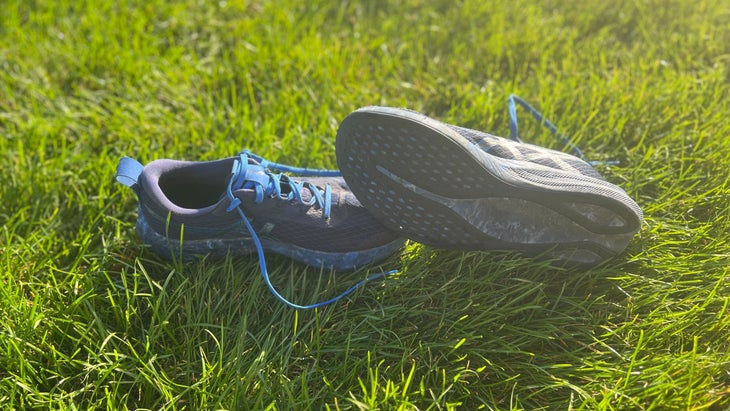
The Asics Noosa Tri 16 is just a fun shoe to run in. Though it has no carbon plate, the nearly 35mm sole goes to work giving a peppy ride for a non-super shoe. While it’s snappy enough for shorter distances, one of the racing shoes from the list is likely better for long distances as the Noosa Tri is more of a daily trainer.
While it’s one of few running shoes specifically designed for triathlon, it isn’t especially fast in transition. Loops on the tongue and heel do help slide the shoe on fast but the lightweight tongue that makes the shoe comfortable for going sockless requires a few extra seconds to prevent folding and discomfort.
| Overall Rating | ★★★★ |
| Overall Value | ★★★★★ |
| Best Distance | Sprint/Olympic |
| Heat Dissipation | ★★★ |
| Water Drainage | ★★★ |
| Sockless Comfort | ★★★★★ |
| Transition Speed | ★★ |
| Durability | ★★★★ |
Specs
| Weight | 7.6 oz, men’s size 9/women’s size 7.5 |
| Stack Height | 34.5-29.5mm / 5mm drop |
| Price | $135 |
New Balance FuelCell Rebel 5
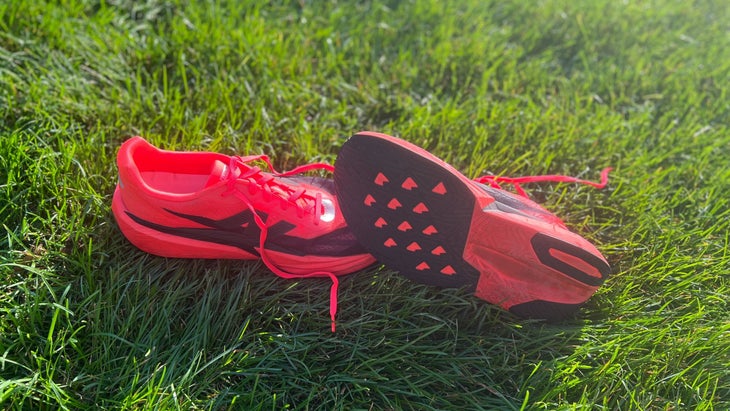
Testers found the New Balance FuelCell Rebel 5 to be pillowy, though that came with both good and bad. While it’s incredibly comfortable, it also has a squash quality with every step instead of a peppy rebound.
With a super breathable upper, the shoe is comfortable in extreme heat and drains well when competing in wet conditions – or when you’re so hot your dumping water and ice left and right. However, don’t plan to wear them sockless, especially in hot, muggy or damp conditions as testers found that to be blister-inducing. The super breathable mesh lacks the softness you want when your skin is right up next to it, though we had no problems with rubbing when wearing socks. Plus, sliding the shoe on sockless in transition was challenging as the insoles didn’t stay put well when slipping a damp, bare foot inside.
| Overall Rating | ★★★ |
| Overall Value | ★★★★ |
| Best Distance | Sprint/Olympic |
| Heat Dissipation | ★★★★ |
| Water Drainage | ★★★★ |
| Sockless Comfort | ★ |
| Transition Speed | ★★★ |
| Durability | ★★★★ |
Specs
| Weight | 8 oz, men’s size 9.5/women’s size 8 |
| Stack Height | 35-29mm / 6mm drop |
| Price | $145 |
Topo Cyclone 3
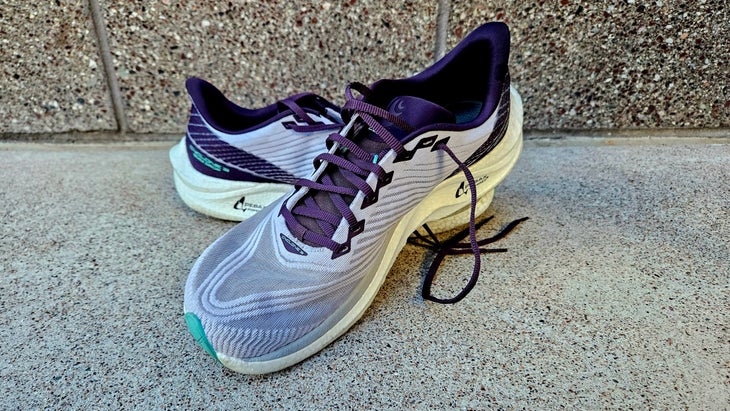
There’s no denying the Topo Cyclones are light – at just a hair under seven ounces, the shoes feel like a featherweight without being flimsy. The midsole is surprisingly nimble, if a little firmer than one might expect from such a light shoe, and in a sea of squishy-foam stacked supershoes, that’s a welcome addition to any runner’s rotation. The mesh cage upper is extremely breathable, making it excellent for both heat dissipation and moisture management in sockless running.
However, with such a large toebox, socks are the only way these shoes will fit on some runners – “spacious” is an understatement. Though room for toes to splay may be preferred by some (the low- to moderate-drop camp, particularly), the giant toe box felt unstable at times, especially when running sockless.
| Overall Rating | ★★★ |
| Overall Value | ★★★★ |
| Best Distance | Olympic |
| Heat Dissipation | ★★★★★ |
| Water Drainage | ★★★★★ |
| Sockless Comfort | ★★★ |
| Transition Speed | ★★★ |
| Durability | ★★★★ |
Specs
| Weight | 6.9 oz, men’s size 12/women’s 10.5 |
| Stack Height | 28-23mm / 5mm drop |
| Price | $155 |